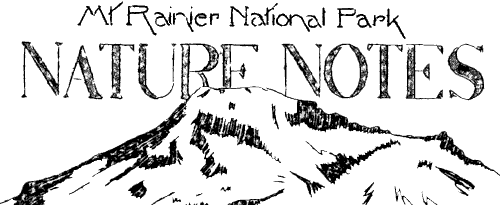
 | ||||||||
Fall brings much of interest to Mount Rainier National Park. But few things exceed that interest which it embodied in the cones of the coniferous trees. One sees them on every hand at this season - many of them spectacular or unique in appearance and all of them interesting. On the Western White Pines hang great numbers of light green,
resinous cones and so great is their number on some trees that one is
reminded of one of those old fashioned chandeliers which decorated, in
scintillating beauty of many glass droplets, the parlors of well to do
homes years ago. For the resin blobs on those cones flash and shines in
the sunlight. Now their scales are compact and close fitting over the
seeds contained therein but soon these cones will open and scatter their
contents about the forest. And then the dry, brown, woody cone - the
empty receptacle where work is done - will also fall to the ground,
perhaps to be picked up and admired by some passer by next summer.
Most interesting of all the cones here is that of the Noble Fir. Like all true firs (genus abies) it stands erect upon the branches rather than being pendant. And also like all of the abies it disintegrates upon maturity scattering scales and seeds to the forest floor. But it owes its interest to the fact of its peculiar bracted appearance and its size. Some eight to ten inches long and three inches in diameter it is further enhanced in beauty by great numbers of bracts that protrude from between the scales and lie flat along the cone like the shingles of a roof. Many visitors have remarked that it appears like a pineapple growing upon our native trees for some reason or other -- and it does bear a resemblance to that delicious fruit. The other native true firs do not have this bracted arrangement nor do they grown to such size though the cone of the Lovely or Amabalis Fir approaches it. On the branches of the Alaska Cedar at this time one will see round, greenish affairs about the size of a small cherry and these are the ones which bear the seeds of that tree. Quite different they are from those of the Western Red Cedar which belongs to a different genus of trees (Thuya) - for these cones are oblong in general outline and upon opening present quite a different appearance. Spruce is also found on Mount Rainier and the cones of these trees have thin, papery scales with wavy margins and thus are readily distinguished from those of other trees in the same vicinity. Cones are interesting and give us an excellent contact for the identification of coniferous trees. (C.F.B.)
Click to see a copy of the original pages of this article (~121K) | ||||||
| <<< Previous | > Cover < | Next >>> |
vol10-10c.htm
17-Nov-2001